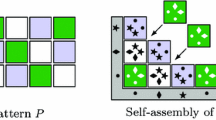Abstract
Patterned self-assembly tile set synthesis (pats) aims at minimizing the number of distinct DNA tile types used to self-assemble a given rectangular color pattern. For an integer k, k-pats is the subproblem of pats that restricts input patterns to those with at most k colors. We give an efficient  verifier, and based on that, we establish a manually-checkable proof for the NP-hardness of 11-pats; the best previous manually-checkable proof is for 29-pats.
verifier, and based on that, we establish a manually-checkable proof for the NP-hardness of 11-pats; the best previous manually-checkable proof is for 29-pats.















Similar content being viewed by others
Notes
In this paper, by pattern, we always mean a rectangular color pattern.
In contrast, for example, \((\mathtt{T}, \mathtt{F}, \mathtt{T}, \mathtt{F})\) does not satisfy \(\phi \) in the
 sense because it satisfies more than one literal of the first clause of \(\phi \).
sense because it satisfies more than one literal of the first clause of \(\phi \).n does not denote a negated variable. Recall that monotonicity requires that variables are never negated in clauses.
Recall that m is the number of variables involved in \(\phi \).
If the second choice in Lemma 2 is made, then there are only 2 tile types left uncolored at this point.
References
Barish R, Rothemund PWK, Winfree E (2005) Two computational primitives for algorithmic self-assembly: copying and counting. Nano Lett 5(12):2586–2592
Brun Y (2008) Solving NP-complete problems in the tile assembly model. Theor Comput Sci 395:31–46
Brun Y (2008) Solving satisfiability in the tile assembly model with a constant-size tileset. J Algorithms 63(4):151–166
Brun Y (2012) Efficient 3-SAT algorithms in the tile assembly model. Nat Comput 11:209–229
Cook M, Rothemund PWK, Winfree E (2004) Self-assembled circuit patterns. In: Proceedings of the 9th International Workshop on DNA Based Computers (DNA 9), LNCS, vol. 2943. Springer, p 91–107
Culik K, Kari J (1997) On aperiodic sets of Wang tiles. Foundations of computer science potential—theory—cognition, LNCS, vol 1337. Springer, Berlin, pp 153–162
Czeizler E, Popa A (2013) Synthesizing minimal tile sets for complex patterns in the framework of patterned DNA self-assembly. Theor Comput Sci 499:23–37
Evans CG (2014) Crystals that count! physical principles and experimental investigations of DNA tile self-assembly. Ph.D. thesis, California Institute of Technology
Göös M, Lempiäinen T, Czeizler E, Orponen P (2014) Search methods for tile sets in patterned DNA self-assembly. J Comput Syst Sci 80:297–319
Johnsen A, Kao MY, Seki S (2013) Computing minimum tile sets to self-assemble patterns in 29-colors. In: Proceedings of the 24th International Symposium on Algorithms and Computation (ISAAC 2013), LNCS, vol. 8283. Springer, p 699–710
Kari L, Kopecki S, Étienne Meunier P, Patitz MJ, Seki S (2015a) Binary pattern tile set synthesis is NP-hard. In: Proceedings of the 42nd International Colloquium on Automata, Languages, and Programming (ICALP 2015), LNCS, vol. 9134. Springer, p 1022–1034
Kari L, Kopecki S, Seki S (2015b) 3-color bounded patterned self-assembly. Nat Comput 14(2):279–292
Ma X, Lombardi F (2008) Synthesis of tile sets for DNA self-assembly. IEEE Trans Comput-Aided Des Integr Circuits Syst 27(5):963–967
Ma X, Lombardi F (2009) On the computational complexity of tile set synthesis for DNA self-assembly. IEEE Trans Circuits Syst II 56(1):31–35
Rothemund PWK, Papadakis N, Winfree E (2004) Algorithmic self-assembly of DNA Sierpinski triangles. PLoS Biol 2(12):e424
Schaefer TJ (1978) The complexity of satisfiability problems. In: Proceedings of the 10th Annual ACM Symposium on Theory of Computing (STOC 1978), p 216–226
Seki S (2013) Combinatorial optimization in pattern assembly (extended abstract). In: Proceedings of the 12th International Conference on Unconventional Computation and Natural Computation (UCNC 2013), LNCS, vol. 7956. Springer, p 220–231
Stefanovic D, Turberfield A (eds) (2012) The 18th International Conference on DNA Computing and Molecular Programming, Aarhus, Denmark, 14–17 August 2012
Winfree E (1998) Algorithmic self-assembly of DNA. Ph.D. thesis, California Institute of Technology
Winfree E (2000) Algorithmic self-assembly of DNA: theoretical motivations and 2D assembly experiments. J Biomol Struct Dyn Special Issue S2:263–270
Winfree E, Liu F, Wenzler LA, Seeman NC (1998) Design and self-assembly of two-dimensional DNA crystals. Nature 394:539–544
Zhang J, Liu Y, Ke Y, Yan H (2006) Periodic square-like gold nanoparticle arrays templated by self-assembled 2D DNA nanogrids on a surface. Nano Lett 6(2):248–251
Acknowledgments
We are very thankful to the anonymous referees for their valuable comments on the earlier versions of this paper. This work is supported in part by NSF Grants CCF-1049899 and CCF-1217770 to M-Y. Kao and by HIIT Pump Priming Grant 902184/T30606, Academy of Finland, Postdoctoral Researcher Grant 13266670/T30606, JST Program to Disseminate Tenure Tracking System, MEXT, JAPAN, No. 6F36, and JSPS Grant-in-Aid for Research Activity Start-up No. 15H06212 to S. Seki.
Author information
Authors and Affiliations
Corresponding author
Rights and permissions
About this article
Cite this article
Johnsen, A., Kao, MY. & Seki, S. A manually-checkable proof for the NP-hardness of 11-color pattern self-assembly tileset synthesis. J Comb Optim 33, 496–529 (2017). https://doi.org/10.1007/s10878-015-9975-6
Published:
Issue Date:
DOI: https://doi.org/10.1007/s10878-015-9975-6





 sense because it satisfies more than one literal of the first clause of
sense because it satisfies more than one literal of the first clause of